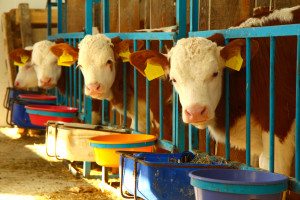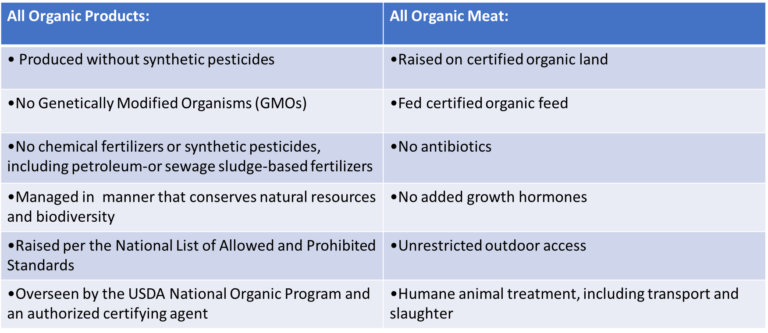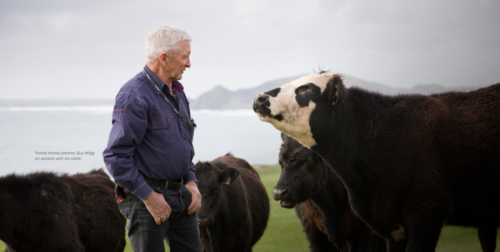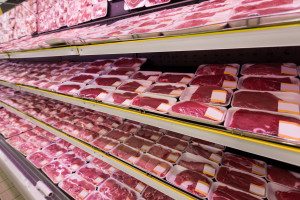

What is Organic Beef?
WHAT IS ORGANIC BEEF? WHY DOES IT MATTER?
Label fatigue is inevitable in the meat department. Organic, natural, antibiotic-free, grass-fed – for those of us trying to eat consciously, it’s confusing at best.
Albeit technical, today’s real talk matters. We’ll define what the organic beef label means, how organic compares to grass-fed beef, and why it matters to us (and hopefully, to you).
A BIT OF BACKGROUND ON ORGANIC
Once upon a time, all farming was organic. In the 1920s, crop dusting, pesticides, and other industrializedmethods allowed for cheap, mass-produced food with higher yield and lower costs.

Over time, feedlots became the norm for meat production – and sadly, they still produce the majority of our country’s meat. In Confined Animal Feeding Operations (CAFOs, AKA feedlots), animals live in confined spaces, receivegrowth-promoting hormones, and eat unnatural diets of corn and grain filled with “preventative” pharmaceuticals and antibiotics. The result? Accelerated growth, cheaper outputs, and more profit. Indeed, since 1960, meat production has tripled at the expense of our animals, our environment, and potentially, our own health.
As consumers became aware – and concerned – about our methods of food production, the USDA created the organic certification in 1990. Organic products meet strict guidelines (below) and are certified through third parties.
Since then, the organic market has flourished. Consumer demand for organic has grown by double digits every year since the 1990s! In 2015, the total retail market for organic products was more than $43 billion (with a “b”) in the US alone, and 82% of Americans purchasing certified organic foods in 2016.
BEHIND THE ORGANIC LABEL
Organic certification encourages practices that “foster cycling of resources, promote ecological balance, and conserve biodiversity.”In short, the organic label means cleaner inputs (e.g. no harmful chemicalsor added hormones), reduced environmental impact, and prioritized animal welfare.

To be specific, organic products must be produced without synthetic pesticides and fertilizers or GMOs and managed in a way that emphasizes conservation and sustainability.
Organic beef producers have additional requirements to ensure the health and welfare of the animals. Animals receive no antibiotics or added growth hormones, are given organic feed, and must have year-round access to the outdoors. Think pastured cattle on sustainably managed lands.
WHY ORGANIC BEEF?
No doubt, the price tag is higher on organic. This reflects the time and labor intensive practices required without conventional shortcuts; in addition, organic farming doesn’t receive the subsidies of conventional industries. One still has to wonder: is organic beef actually better?
We think so, and we’re not alone. According to data from Nielsen, while conventional beef sales are declining,organic beef sales volume has grown 30% over the past year– and 30% of consumers want more organic meat on the shelves.
According to FMI’s 2017The Power of Meatreport, shoppers report buying organic for a number of reasons:
- Free of substances I wish to avoid (especially antibiotics and added hormones);
- Better health/treatment of the animals;
- Long-term personal health effect;
- Freshness and better taste;
- Less environmental impact.
IS ORGANIC BETTER FOR THE ANIMALS?
Compared to conventional? Yes, yes, and yes.

As discussed, the organic seal explicitly requires the humane treatment of animals, including access to pasture and prohibitionof added hormones.
At the risk of ruining your appetite…
This stands in stark contrast to conventionally-raised beef. Industrial feedlots can cram thousands of animals into pens. The result is often horribly unsanitary conditions. As ruminants, cattlehave evolved to eat grass; but in CAFOs, animals are typically fed a diet of grain and corn — and even animal by-products, waste, or candy (seriously) — to cheaply accelerate growth.
Between unnatural diets and unsanitary conditions, animals get sick and stressed. As a result, feed must be pumped with prophylactic antibiotics and pharmaceuticals. Animals also receive growth hormones and beta-agonists topromote rapid weight gain.
Importantly, beef can be humanely produced without being organic. Farmers can still raise cattle in stress-free conditions, on well-managed pasture, eating a diet of grass without being certified organic. More on that below
IS ORGANIC BETTER FOR THE ENVIRONMENT?
Unfortunately, the negative effects of CAFOs extend beyond the animals.

As reported by the CDC, CAFOs are a hazard to our water supplies (due in large part to the runoff of poorly managed waste), contaminate our air, and expose farm workers to harmful chemicals and pesticides.
Organic systems, meanwhile, can have significant environmental benefits. 23 years of studiesby Michel Cavigelli of the USDA found that organic systems:
- Have more fertile soil;
- Use less fertilizer and much less herbicide;
- Use less energy;
- Lock away more carbon in the soil – a critical component in combatting climate change.
Bottom line: organic practices proactively support long-term sustainability. To us, it’s a no-brainer.
IS ORGANIC BETTER FOR YOUR HEALTH?
The short answer? It depends on who you ask, so it’s on you to decide.(Side note: grass-fed beef has a number of health benefitsassociated… but that’s a different post.)
Let’s start with nutrition. The scientific community is conflictedabout the nutritional benefits of organic food. One major meta-analysisfound no significant difference between conventional and organic food, while other studiesfind substantially higher concentrations of a range of antioxidants and beneficial compounds, such as Omega-3s.
As for substances prohibited by organic standards – like GMOs, chemicals, pesticides, antibiotics, and added hormones — long-term health effects are also unclear. Yet, you might consider that 600 active chemicals are registered for agricultural use in America and 90% of chemicals applied to foods have not been tested for long-term health effects before being marked safe.
Moreover, tens of millions of pounds of antibiotics are used in animal feed every year; indeed, 70% of antibiotics produced in the US fed to animals for sub-therapeutic purposes. Many scientists relate this use to the creation of drug-resistant pathogens and other negative human conditions. Meanwhile, the European scientific community has banned the use of all growth-hormones; they’ve determined that none of the hormones currently used in the US have an acceptably safe level.

THE TAKEAWAY ON ORGANIC BEEF
First off,don’t panic.Fear = bad; awareness = good.
Our take? Use common sense. Not all conventional food isthe enemy, but good food is an investment our health and our planet. As consumers, we do the best we can with the knowledge and options we have. And to us, food that is raised right feels better and tastes better.
To learn more about the differences between conventional beef and sustainable systems, check out Consumer Reports 2015 Beef Report. It’s not for the feint of heart; the report goes into detail on the conditions in CAFOs and it’s not pretty.
MORE ON LABEL FATIGUE: GRASS-FED VS. ORGANIC BEEF
The plot thickens. Many consumers confuse grass-fed with organic – isn’t it the same thing? Nope. Grass-fed beefcanbe organic and organic beefcanbe grass-fed, but that’s not always the case.

Grass-fed beef comes from cattle that are raised on a diet of primarily grass – vs. grain or corn in conventionally-raised beef. As we’ve discussed,grass-fed beef has a number of profound health benefits. When cattle eat a diet ofonlygrass, from start to finish, beef may be labeled 100% grass-fed.
Butthe pastures themselves may not be organic certified, nor are cattle necessarily raised on pasture. Unless a product is marked “free range,” “pasture-raised,” or “organic,” cattle could be eating grass in confined and/or stressful conditions, or animals may be finished in a feedlot. Without the notes of “no added hormones or antibiotics,” these substances may also be in play.
Conversely, cattle may eat a partial or primary diet of grain and/or corn, but as long as the farmer meets organic requirements – raised on pasture, no added hormones, certified organic feed, etc. – they qualify for the organic seal.
“NATURAL” BEEF
Natural is a diluted term that almost intentionally confuses consumers. The label only means the item contains no artificial ingredients or added color and is only minimally processed. No mention of hormones, antibiotics, animal conditions, or use of chemicals in production.
CHOOSE BETTER BEEF
Dana Ehrlich founded Verde Farms to transform how we eat beef — to move from an inhumane feedlot system to higher standards of quality beef.
Our 100% Organic, 100% Grass-Fed Beefis our flagship line. Why? We believe that organic, grass-fed beef is the best choice to support animal welfare, environmental sustainability, and personal health.
Our other two product lines, “100% Grass-Fed Never Ever” and “Free RangeGrass-Fed,” are not certified organic beef. Yet we create all of our productswith values, with care for the animals and the environment. Unlike some other brands of grass-fed beef, we NEVER use feedlots, addedgrowth hormones or preventative antibiotics, and we always raise our animals according to stringent animal welfare guidelines.By offering a wider product range, we broaden access to better beefthroughmore approachable price points.
Learn to read the labels. Ask questions. Decide what’s important to you. Eat better beef.